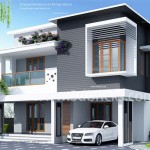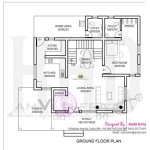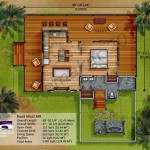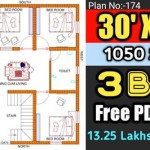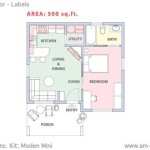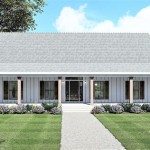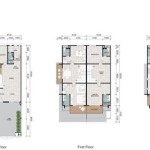30 Best House Plan Ideas for Your Dream Home
Selecting the right house plan is a pivotal step in creating a functional and aesthetically pleasing home. The ideal plan should align with personal lifestyle, budget, and the characteristics of the building site. With a vast array of options available, navigating the selection process can feel overwhelming. This article explores 30 different house plan ideas, offering insights into various styles and features to aid in informed decision-making.
Understanding Your Needs and Preferences
Before diving into specific house plans, it is crucial to establish clear requirements. This involves assessing the size of the household, lifestyle habits, and any specific needs, such as home office space or accessibility requirements. A thorough understanding of these factors will significantly narrow down the possibilities and streamline the search for the perfect house plan.
Consider the number of bedrooms and bathrooms required to comfortably accommodate all residents. Think about the need for dedicated spaces like a home office, media room, or hobby area. Also, evaluate how often the living spaces will be used for entertaining, as this will influence the size and layout of the kitchen, dining room, and living room. Finally, if anyone in the household has mobility issues, prioritize plans that incorporate universal design principles, such as wider doorways and accessible bathrooms.
Beyond practical considerations, personal preferences also play a significant role. Do you prefer a traditional architectural style, or are you drawn to more modern designs? Are you fond of open-concept layouts, or do you prefer distinct rooms with defined boundaries? These preferences will guide you towards certain types of house plans and help you eliminate others that do not align with your aesthetic sensibilities.
Exploring Diverse House Plan Styles
House plans come in a diverse range of styles, each with its unique characteristics and features. From classic colonial homes to contemporary minimalist designs, there is a style to suit every taste. Here are 30 examples to explore:
- Ranch: Single-story home with an open layout and attached garage.
- Two-Story: Offers more living space on a smaller footprint, typically with bedrooms upstairs.
- Cape Cod: Symmetrical design with a central chimney and dormer windows.
- Colonial: Rectangular shape with evenly spaced windows and a grand entrance.
- Craftsman: Emphasizes handcrafted details, exposed rafters, and a large front porch.
- Victorian: Ornate details, asymmetrical design, and multiple gables.
- Farmhouse: Characterized by a simple, functional design with a large kitchen and wraparound porch.
- Mid-Century Modern: Clean lines, open floor plans, and large windows that bring the outdoors in.
- Contemporary: Focuses on simplicity, functionality, and sustainable design.
- Mediterranean: Stucco exterior, tile roof, and arched doorways.
- Tudor: Steeply pitched roof, exposed timber framing, and decorative chimneys.
- French Country: Elegant design with a symmetrical facade and a steeply pitched roof.
- Modern Farmhouse: Combines the rustic charm of a farmhouse with modern amenities and clean lines.
- Minimalist: Emphasizes simplicity, clean lines, and minimal ornamentation.
- Split-Level: Features multiple levels connected by short flights of stairs.
- Bungalow: Compact, single-story home with a low-pitched roof and a large front porch.
- Cottage: Small, charming home with a cozy interior and a garden setting.
- Cabin: Rustic design with a focus on natural materials and a connection to the outdoors.
- Log Home: Constructed from logs, offering a rustic and durable design.
- Prairie: Horizontal lines, low-pitched roof, and large windows that blend with the landscape.
- Spanish Colonial: White stucco exterior, red tile roof, and arched doorways.
- Geodesic Dome: Unique spherical structure that is energy-efficient and durable.
- A-Frame: Triangular shape with a steeply pitched roof that extends to the ground.
- Saltbox: Asymmetrical design with a long, sloping roof in the back.
- Greek Revival: Grand columns, symmetrical facade, and a triangular pediment.
- Four Square: Simple, boxy shape with a central staircase and four rooms on each floor.
- Barndominium: Combines a barn and a condominium, offering a spacious and versatile living space.
- Earthship: Sustainable design using recycled materials and earth-berming for temperature regulation.
- Shipping Container Home: Constructed from repurposed shipping containers, offering a unique and sustainable design.
- Tiny House: Small, minimalist home that focuses on efficiency and sustainability.
Key Considerations for Choosing the Right Plan
Selecting the ideal house plan involves considering several critical factors beyond personal style preferences. These include budget limitations, site constraints, and future needs. Overlooking these aspects can lead to costly modifications and dissatisfaction with the final result.
Budget: The budget allocated for construction significantly influences the choice of house plan. More complex designs with intricate features and expensive materials will naturally cost more to build. It is crucial to establish a realistic budget upfront and select a plan that aligns with financial constraints. Consider not only the cost of materials and labor but also potential landscaping, permits, and other associated expenses.
Site Conditions: The physical characteristics of the building site also play a crucial role in determining the suitability of a particular house plan. Factors such as the size and shape of the lot, the slope of the land, soil conditions, and local zoning regulations can all impact the feasibility and cost of construction. For example, a sloped lot may require a more complex foundation design or a multi-level house plan. It is advisable to consult with a builder or architect to assess the site conditions and select a plan that complements the landscape.
Future Needs: Anticipating future needs is essential for ensuring that the chosen house plan remains suitable for the long term. Consider potential lifestyle changes, such as the possibility of expanding the family, accommodating aging parents, or working from home more frequently. Selecting a plan with flexible spaces that can be adapted to different uses over time will provide greater long-term value and satisfaction. Also, consider the potential resale value of the home and choose a plan that appeals to a broad range of buyers.
By carefully considering these 30 house plan ideas and evaluating your needs, preferences, and budget limitations, you can navigate the selection process with confidence and create a home that perfectly suits your lifestyle.

30 By House Plan With Car Parking Best Designs Duplex Plans Bedroom

30 Cool House Plan Ideas For Diffe Areas Engineering Discoveries Plans Best Simple

30 X 40 Simple House Plan Ii Home Design Ghar Ka Naksha Best Plans North Facing

30 X 50 House Plan 30x50 With Car Parking By Garden Plans Best

What Are The Best House Plans Or Architecture For A 30 Ft X 40 Home

What Are The Best House Plans Or Architecture For A 30 Ft X 40 Home
Free House Plans Blueprints Civiconcepts

What Are The Best House Plans Or Architecture For A 30 Ft X 40 Home

30x50 House Plans Plan Architect Residential Architecture

Best Small House Designs 9x6 Meter 30x20 Feet Design Plan

